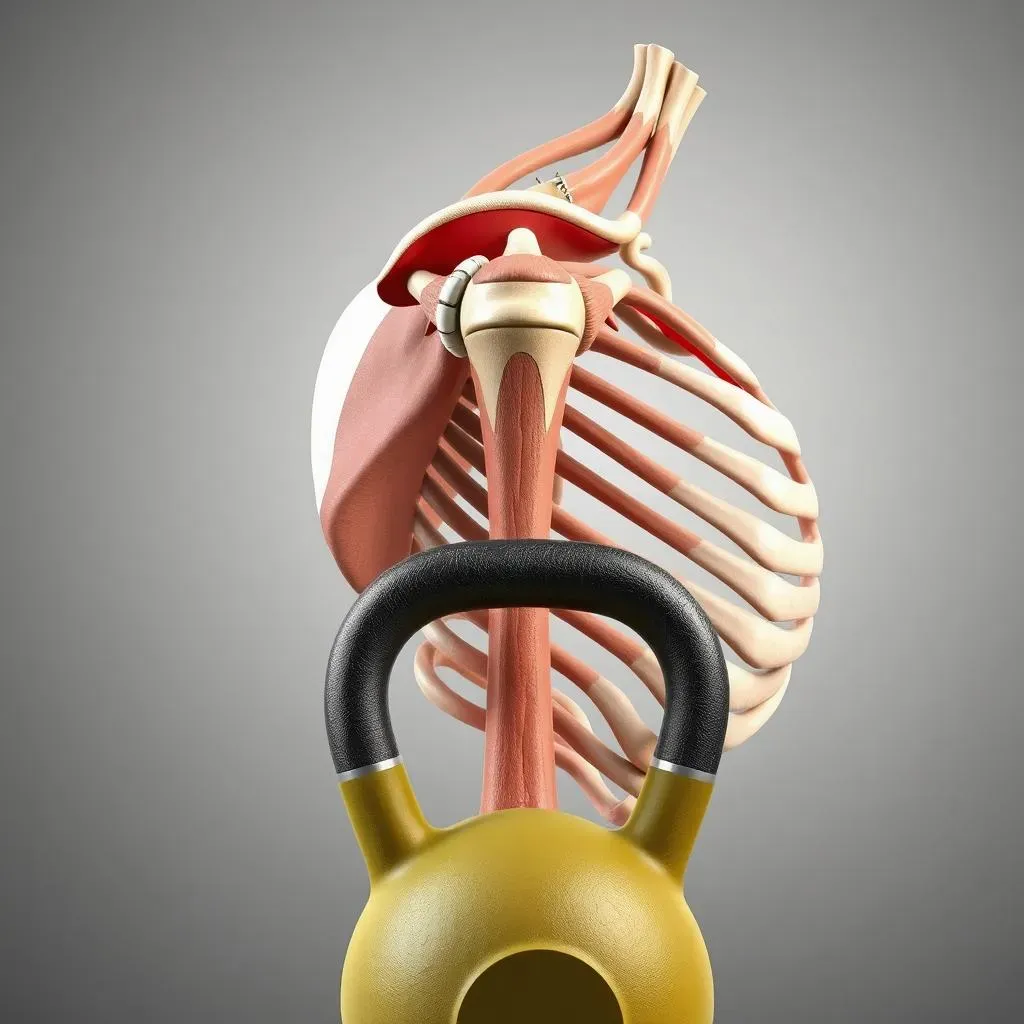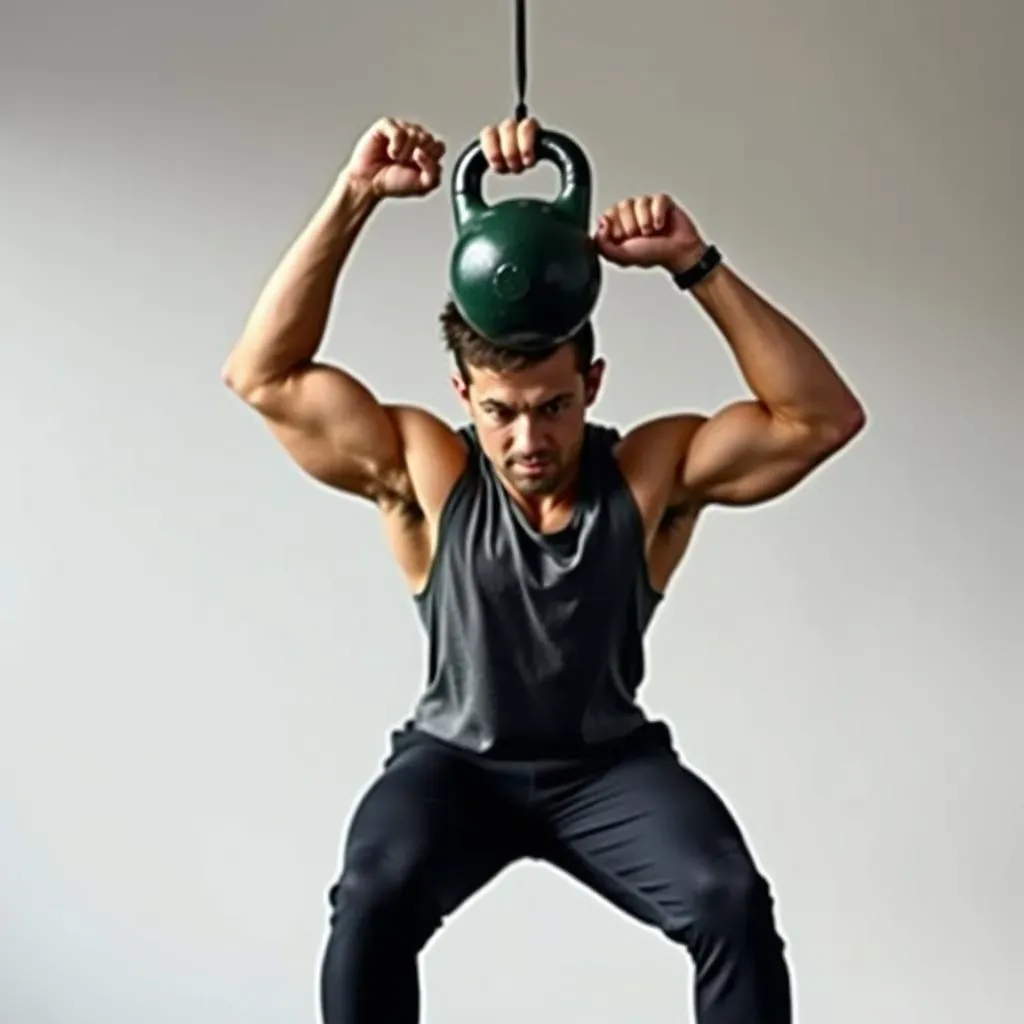Table of Contents
Your shoulders: they're complex, capable of incredible movement, and also surprisingly prone to injury. Before you jump into heavy lifting, especially with tools like kettlebells, it’s crucial to build a solid foundation of stability. Think of it like constructing a building – you wouldn't start adding floors before ensuring the base is rock solid, right? This article is your blueprint for building resilient, strong shoulders using kettlebells. We'll dive into the anatomy of your shoulder joint, highlighting why stability is paramount before strength. Then, we'll guide you through ten of the best kettlebell exercises specifically designed to enhance shoulder health, gradually progressing from foundational stability work to more demanding strength exercises. Get ready to learn how to safely and effectively incorporate a kettlebell workout shoulders into your fitness routine, minimizing risk and maximizing results. We'll also cover common mistakes to avoid and provide a sample workout to get you started. So, let's swing into action and build those bulletproof shoulders!
Understanding Shoulder Anatomy for Effective Kettlebell Workouts

Understanding Shoulder Anatomy for Effective Kettlebell Workouts
Alright, let's talk shoulders! Before you even think about picking up a kettlebell, it's key to understand what's going on under the hood. Your shoulder isn't just one joint; it's a whole complex of joints, muscles, ligaments, and tendons all working together. We're talking about the glenohumeral joint (where your arm bone meets your shoulder blade), the acromioclavicular joint (where your collarbone meets your shoulder blade), the sternoclavicular joint (where your collarbone meets your sternum), and the scapulothoracic joint (where your shoulder blade glides along your rib cage). Each of these plays a vital role in shoulder movement and stability. When it comes to kettlebell exercises, all these parts need to be working in harmony to prevent injuries and maximize your gains.
10 Essential Kettlebell Exercises for Shoulder Strength and Stability

10 Essential Kettlebell Exercises for Shoulder Strength and Stability
Straight Arm Overhead Kettlebell Hold
Alright, let's kick things off with a deceptively simple exercise: the Straight Arm Overhead Kettlebell Hold. I know, it sounds easy, but trust me, holding a kettlebell straight overhead with a locked-out elbow for an extended period is a real challenge for your shoulder stability. It forces your rotator cuff muscles to work overtime to keep that weight in place. This isn't about brute strength; it's about control and endurance. It's like teaching your shoulder to brace itself against the pull of gravity.
Think of it as a moving plank for your shoulder. You're not just holding the weight; you're actively resisting the urge to let your shoulder shrug, your elbow bend, or your wrist wobble. Focus on keeping your shoulder blade packed down and back, your core engaged, and your body in a straight line from head to toe. Start with shorter holds (like 20-30 seconds) and gradually increase the duration as your stability improves. This exercise is fantastic for building a solid foundation for more complex overhead movements.
"The Straight Arm Overhead Kettlebell Hold is a fantastic way to improve shoulder stability and build a solid foundation for more complex overhead movements." - Anonymous Fitness Expert
Kettlebell Windmill
Next up, we have the Kettlebell Windmill, a move that's as much about flexibility and core strength as it is about shoulder stability. This exercise challenges your shoulder in multiple planes of motion while also demanding a lot from your hamstrings and obliques. It's a full-body party with a strong emphasis on shoulder control.
The key to a good Kettlebell Windmill is to maintain a straight arm with the kettlebell overhead while hinging at your hips and reaching down towards the floor with your opposite hand. Keep your eyes on the kettlebell throughout the movement to help maintain shoulder stability. Don't worry about touching the floor; focus on keeping your back straight and your core engaged. This exercise will not only improve your shoulder stability but also increase your hip mobility and core strength.
Exercise | Sets | Reps/Hold Time | Rest |
|---|---|---|---|
Straight Arm Overhead Kettlebell Hold | 3 | 20-60 seconds | 60 seconds |
Kettlebell Windmill | 3 | 5-8 per side | 60 seconds |
Progressing Your Kettlebell Shoulder Workout: From Stability to Strength

Progressing Your Kettlebell Shoulder Workout: From Stability to Strength
Building a Solid Base
so you've mastered the Straight Arm Overhead Hold and you're feeling pretty good with the Windmill. Awesome! But before you start slinging heavy kettlebells overhead like a circus performer, it's crucial to understand the importance of progressive overload. You wouldn't try to run a marathon without training, would you? Same goes for your shoulders. Start with lighter weights and focus on perfect form. The goal here is to build a solid foundation of stability and control before adding more load or complexity. Think quality over quantity.
I always tell people to treat their shoulders like delicate flowers – nurture them, don't abuse them. This means listening to your body, paying attention to any pain or discomfort, and adjusting your training accordingly. Don't be afraid to scale back the weight or modify the exercise if needed. Remember, the goal is long-term shoulder health, not short-term ego gratification. Before even thinking about adding weight, make sure you can confidently perform the foundational exercises with impeccable form.
Adding Load and Complexity
Once you've established a solid base of stability, it's time to gradually increase the challenge. This can be done in several ways: increasing the weight of the kettlebell, increasing the number of repetitions, increasing the duration of the holds, or progressing to more complex exercises. For example, once you can comfortably hold a kettlebell overhead for 60 seconds, you might consider increasing the weight by a few pounds. Or, once you can perform 8 repetitions of the Kettlebell Windmill per side, you might try adding a slight pause at the bottom of the movement.
The key is to make small, incremental changes and to always prioritize form. Don't jump from a 12kg kettlebell to a 24kg kettlebell overnight. That's a recipe for disaster. Instead, gradually increase the weight in 2-4kg increments. And don't be afraid to experiment with different exercises and variations to find what works best for you. The goal is to constantly challenge your shoulders in new and interesting ways, while always maintaining a focus on safety and control.
Avoiding Injuries: Proper Form and Technique in Kettlebell Shoulder Exercises

Avoiding Injuries: Proper Form and Technique in Kettlebell Shoulder Exercises
Prioritize Proper Posture and Alignment
Look, before you even think about swinging a kettlebell around your head, make sure your posture is on point. We're talking about a neutral spine, a tucked chin, and shoulders that are packed down and back. Think of it like this: your body is a machine, and if the alignment is off, the machine is going to break down. Good posture isn't just about looking good; it's about creating a stable base of support for your shoulder joint. When your spine is aligned and your shoulders are properly positioned, your muscles can work more efficiently and your joints are less likely to get stressed.
A simple way to check your posture is to stand in front of a mirror and look at your side profile. Are your ears aligned with your shoulders, hips, and ankles? Is your lower back excessively arched? If so, you need to make some adjustments. Practice standing tall with your chest open and your shoulder blades gently squeezed together. You can also try doing some wall slides or doorway stretches to improve your posture. Remember, good posture is a habit, so make a conscious effort to maintain it throughout the day, not just during your kettlebell workouts.
Engage Your Lats and Stabilize Your Scapula
Now, let's talk about the lats – those big muscles in your back that play a crucial role in shoulder stability. Engaging your lats helps to depress and stabilize your scapula (shoulder blade), which in turn creates a more solid foundation for your shoulder joint. Think of your lats as the anchor that keeps your shoulder from floating around aimlessly. When you're performing kettlebell exercises, consciously try to activate your lats by pulling your shoulder blades down and back.
One way to practice this is to perform some lat pulldowns or rows with a light weight. Focus on squeezing your shoulder blades together and down as you pull the weight towards your chest. You can also try doing some scapular retractions, where you simply squeeze your shoulder blades together without any weight. The key is to develop a mind-muscle connection with your lats so that you can consciously engage them during your kettlebell workouts. This will not only improve your shoulder stability but also help you generate more power and control in your movements.
"Engaging your lats is like putting a seatbelt on your shoulder – it keeps everything secure and prevents injury." - Fitness Expert
Control the Descent and Avoid Momentum
Alright, listen up, because this is where a lot of people mess up: controlling the descent. It's tempting to just let the kettlebell drop back down after you've lifted it overhead, but that's a surefire way to injure your shoulder. The eccentric (lowering) phase of the exercise is just as important as the concentric (lifting) phase, if not more so. This is where your muscles are working to decelerate the weight and control the movement.
Instead of letting gravity do all the work, actively resist the downward pull of the kettlebell. Engage your lats, brace your core, and slowly lower the weight back to the starting position. Focus on maintaining control throughout the entire range of motion. And for the love of all that is holy, avoid using momentum to swing the kettlebell around. Momentum might make the exercise feel easier, but it also takes the focus off your muscles and puts unnecessary stress on your joints. Think slow and controlled, not fast and sloppy.
Key Injury Prevention Tip | Description |
|---|---|
Maintain Neutral Spine | Keep your back straight and avoid excessive arching or rounding. |
Engage Lats | Actively pull your shoulder blades down and back to stabilize your shoulders. |
Control Descent | Resist the downward pull of the kettlebell and lower it slowly. |
Avoid Momentum | Use your muscles, not momentum, to lift and lower the kettlebell. |
Sample Kettlebell Workout Shoulders Routine and Training Tips

Sample Kettlebell Workout Shoulders Routine and Training Tips
Warm-Up: Preparing Your Shoulders for Action
Alright, before you even think about grabbing that kettlebell, let's get those shoulders warmed up and ready to rock. A proper warm-up is absolutely essential for preventing injuries and maximizing your performance. We're not talking about some half-hearted arm circles here. We need to actively engage those muscles and get the blood flowing. Start with some dynamic stretches like arm circles (forward and backward), shoulder rotations, and cross-body arm stretches. These movements will help to increase your range of motion and loosen up any tight spots.
Next, let's move on to some light resistance exercises to further activate the shoulder muscles. You can use a resistance band or a very light kettlebell for these. Try doing some band pull-aparts, face pulls, and external rotations. Focus on squeezing your shoulder blades together and down as you perform these exercises. This will help to engage your lats and stabilize your scapula, which, as we discussed earlier, is crucial for shoulder stability. Spend at least 5-10 minutes on your warm-up before moving on to the main workout. Trust me, your shoulders will thank you for it.
The Workout: A Sample Kettlebell Shoulder Routine
now for the main event: a sample kettlebell workout shoulders routine that you can use to build strength and stability. This routine is designed to be challenging but also scalable, so you can adjust the weight and repetitions to suit your fitness level. Remember, it's always better to start with lighter weights and focus on perfect form than to go too heavy and risk injury. We're going to focus on a combination of stability exercises and strength exercises to give you a well-rounded shoulder workout.
Here's the routine:
- Straight Arm Overhead Kettlebell Hold: 3 sets of 30-60 seconds hold
- Kettlebell Windmill: 3 sets of 5-8 reps per side
- Kettlebell Shoulder Press: 3 sets of 8-12 reps per side
- Kettlebell Push Press: 3 sets of 8-12 reps per side
- Kettlebell Clean and Press: 3 sets of 5-8 reps per side
Rest for 60-90 seconds between sets. As you get stronger, you can gradually increase the weight of the kettlebell or the number of repetitions. Remember to always prioritize form over weight.
Cool-Down: Recovery and Flexibility
Alright, you've crushed your workout, but we're not done yet. The cool-down is just as important as the warm-up for promoting recovery and preventing soreness. After your workout, spend at least 5-10 minutes stretching your shoulder muscles. Focus on static stretches, where you hold the stretch for 20-30 seconds. Some good stretches for the shoulders include cross-body arm stretches, overhead triceps stretches, and doorway stretches.
In addition to stretching, you can also try some foam rolling to release any tension in your shoulder muscles. Foam rolling is a form of self-massage that can help to improve blood flow and reduce muscle soreness. Focus on rolling out your lats, traps, and rotator cuff muscles. And don't forget to hydrate and refuel your body with some protein and carbohydrates to help your muscles recover. A proper cool-down will not only help you feel better but also prepare you for your next workout.
Cool-Down Activity | Description | Duration |
|---|---|---|
Static Stretching | Hold each stretch for 20-30 seconds. | 5-10 minutes |
Foam Rolling | Roll out lats, traps, and rotator cuff muscles. | 5-10 minutes |
Hydration and Refueling | Drink water and eat a protein-rich snack. | As needed |
Conclusion
Building strong and stable shoulders with kettlebells is a journey, not a sprint. Remember to prioritize stability exercises before progressing to heavier loads and more complex movements. Mastering the fundamentals, like the Turkish Get Up and Windmill, will pay dividends in your overall shoulder health and performance. Listen to your body, focus on proper form, and don't be afraid to scale back when needed. By consistently incorporating these kettlebell exercises into your routine, you'll not only enhance your shoulder strength and stability but also improve your overall functional fitness and reduce your risk of injury. Now go forth and conquer those kettlebell workout shoulders!